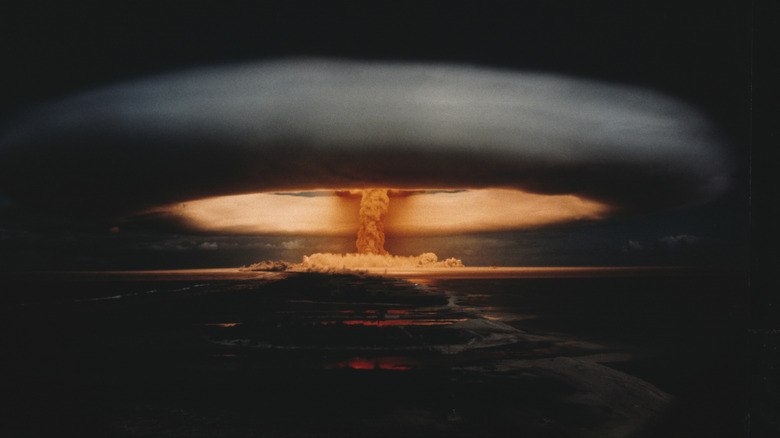Is The 'Rule Of Thumb' From The Fallout Series Really Capable Of Saving Lives?
Fans of Bethesda's "Fallout" video game series are more than well-acquainted with Vault Boy, the game's iconic, blue-suited, blonde-coifed, smiling mascot who's typically jabbing a thumbs up toward the camera. The recent Amazon Prime adaptation of the game series has garnered a lot of critical and commercial success, did a shockingly good job adapting the game world to the small screen, and is already slated for a 2nd season. And, as many articles online have pointed out by now: Vault Boy's thumbs up isn't just Bethesda approving the influx of loads of cash.
For those unfamiliar with the show or the game, "Fallout" takes place in a radiation-blighted wasteland following a nuclear apocalypse. Vault Boy encapsulates and satirizes the misplaced, crestfallen, and somewhat delusional optimism that post-World War II America clung to during the Cold War's atomic terror. Hence the thumbs up. In Episode 1 of the Amazon series, however, Walton Goggins' gunslinging character Cooper Howard offers up an alternative explanation for the thumbs up: Hold your thumb up to a nuclear blast, and if your thumb covers the explosion, you've got time to run. If not, maybe you've got time to pray.
While this might sound like a clever, simple rule of thumb (so to speak), things are way more complicated than that. Nuclear bombs generate four different types of damage: radiation, thermal, light, and blast. Environmental conditions affect each of these damage types, and there's no singular rule to determine if you're far enough away to be safe.
Concentric circles of nuclear damage
Nuclear explosions are much more complex and devastating than conventional explosions. To illustrate, let's look at the Nuke Map by historian Alex Wellerstein, an interactive map with tons of parameters that let you check the effects of nuclear weapons dropped anywhere in the world. Going the simple route, let's arbitrarily choose to drop Little Boy — the 15-kiloton nuclear bomb dropped on Hiroshima during World War II — on the financial district of Manhattan.
Multiple damage types spread in concentric circles from the epicenter of nuclear blasts. From smallest to largest in our simulation, there's the initial nuclear fireball, followed by heavy blast damage, moderate blast damage, initial radiation damage, thermal radiation damage, and finally light blast radiation damage that makes it west over the Hudson River and into Jersey City — if the bomb detonates on the ground, that is. Detonations in the atmosphere are more severe as blast layers propagate through air much more easily than land and all of its man-made structures. And then there's wind, which radically alters nuclear fallout. If the wind in our example is blowing northeast, radiation could get carried in a line all the way to New Haven.
On top of all this: How big is your thumb? How long is your arm? What's your height relative to the blast? Which damage type are you assessing? And, do you know the exact explosive yield of the nuclear device? Such questions ought to illustrate that the rule of thumb is much less effective than an even simpler rule: run and hide.
Vaguely useful in a pinch
To be fair, "Fallout's" rule of thumb could be vaguely useful if we've accounted for every single average of all the possible parameters mentioned above: size of thumb, length of arm, height of bomb, explosive yield of device, and most pertinently, wind direction and strength. This is because, as mentioned, wind carries radiation far further than anyone might realize. In our previous financial district example, if you're standing in Stamford, Connecticut and holding your thumb toward Manhattan 40 miles away, you might not even see a nuclear explosion given atmospheric conditions and the height at which the nuclear device detonated. But, if the wind is blowing your way, you'll definitely get caught in the fallout.
And yet, even academics have calculated the viability of "Fallout's" rule of thumb. A team at the University of Leicester in 2018 also chose the explosive yield of Little Boy — 15 kilotons — as an example. If a thumb of unspecified size was "just covering the stem of the [mushroom] cloud," then a person would be about 7.8 miles away from ground zero. A distance of about 2.9 miles would be enough to avoid "all burns," and 1 mile enough to avoid initial radiation saturation. And the farther away you are from the blast, regardless of wind direction and strength, the less "rads" (radiation absorbed dose) you'd absorb. This might sound like a promising way to save lives — when facing an 80-year-old nuclear device from World War II — but we wouldn't recommend hanging around to find out.


